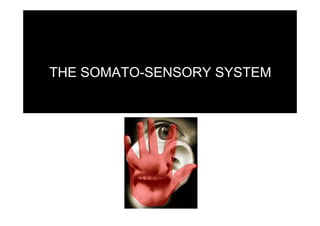
Ch12
- 2. SOMATIC SENSATION Enables body to feel, ache, chill. Responsible for feeling of touch and pain Different from other systems because receptors are widely distributed throughout all the body and responds to different kinds of stimuli Types and layers of skin Hairy and glabrous (hairless) Epidermis (outer) and dermis (inner) Functions of skin Protective function Prevents evaporation of body fluids Provides direct contact with world Mechanoreceptors Most somatosensory receptors are mechanoreceptors. Pacinian corpuscles Ruffini's endings Meissner's corpuscles Merkel's disks Krause end bulbs
- 4. TOUCH RECEPTORS Two-point discrimination varies across the body surface (Importance of fingertips over elbow). Difference in density of receptors, size of receptive fields, brain tissue devolved in processing the information Big toe sole calf back lip forearm thumb Index finger
- 5. PRIMARY AFFERENT AXONS white matter Gray matter Dorsal root Big toe Dorsal root ganglion Dorsal root ganglion cell receptor Dorsal Spinal root nerve lip Primary Afferent Axons Aα, Aβ, Aδ, C C fibers mediate pain and temperature A β mediates touch sensations
- 7. THE SPINAL CORD Divided in spinal segments (30)- spinal nerves within 4 divisions Dermatomes (area of the skin innervate by the R and L dorsal roots of a single spinal segment) have 1-to-1 correspondence with segments
- 8. THE SPINAL CORD Division of spinal gray matter: Dorsal horn; Intermediate zone; Ventral horn Myelinated Aβ axons (touch-sensitive) mainly synapses in the dorsal horn with the second order sensory neurons
- 9. ASCENDING PATHWAYS Dorsal Column–Medial Lemniscal Pathway The Trigeminal Touch Pathway Touch information ascends through dorsal Trigeminal nerves column, dorsal nuclei, medial lemniscus, Cranial nerves and ventral posterior nucleus to primary somatosensory cortex S1 S1 dorsal column nuclei VPN trigeminal nucleus VPN dorsal column Medial lemniscus From face
- 10. SOMATOSENSORY CORTEX Primary is area 3b Receives dense input from VP nucleus of the thalamus Lesions impair somatic sensations Electrical stimulation evokes sensory experiences Area 3a receive information from vestibular system Area 1 receive information from 3b and code for texture Area 2 receive information from 3b and code for size and shape Other areas Posterior Parietal Cortex (5,7)
- 11. SOMATOSENSORY CORTEX Cortical Somatotopy (Homunculus)
- 12. SOMATOSENSORY CORTEX Cortical Map Plasticity Remove digits or overstimulate – examine somatotopy before and after Showed reorganization of cortical maps
- 13. SOMATOSENSORY CORTEX The Posterior Parietal Cortex Involved in somatic sensation, visual stimuli, and movement planning Lesion has been associated to: Agnosia, Astereoagnosia and Neglect syndrome
- 14. PAIN Pain - feeling associated to nociception Nociception - sensory process, provides signals that trigger pain Nociceptors: Transduction of Pain Bradykinin , Mast cell activation: Release of histamine Types of Nociceptors: Polymodal, Mechanical, Thermal and Chemical Hyperalgesia: higher sensitivity to pain in tissue already damaged Primary occurs in the damaged tissues and secondary hyperalgesia in the surroundings Bradykinin, prostaglandins, and substance P (secondary hyperalgesia)
- 15. PAIN Primary Afferents First pain mediated by fast axons and second pain by slower C fibers Spinal mechanisms brain Dorsal root Ventral root
- 16. PAIN ASCENDING PATHWAYS Main differences between touch and pain pathway Nerve endings in the skin Spinothalamic Pain Pathway Diameter of axons Connections in spinal cord Touch – Ascends Ipsilaterally Pain – Ascends Contralaterally Two pathways: 1) Spinothalamic Pain Pathway 2) The Trigeminal Pain Pathway
- 18. REGULATION OF PAIN Afferent Regulation: gate theory of pain Dorsal horn To dorsal column To spinothalamic tract
- 19. REGULATION OF PAIN Descending pain control pathway. Use of serotonin Stimulation of the PAG cause deep analgesia The endogenuos opiates Opioids and endomorphins Primary auditory cortex Secondary auditory cortex
- 20. TEMPERATURE Thermoreceptors “Hot” and “cold” receptors. Varying sensitivities The Temperature Pathway Identical to pain pathway Cold receptors coupled to Aδ and C Hot receptors coupled to C
